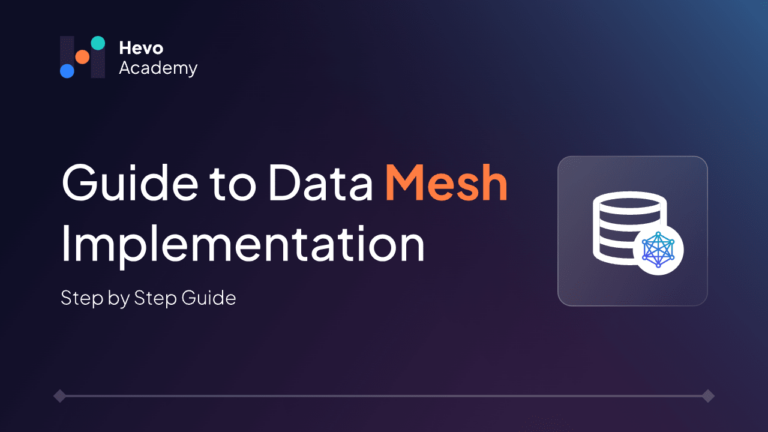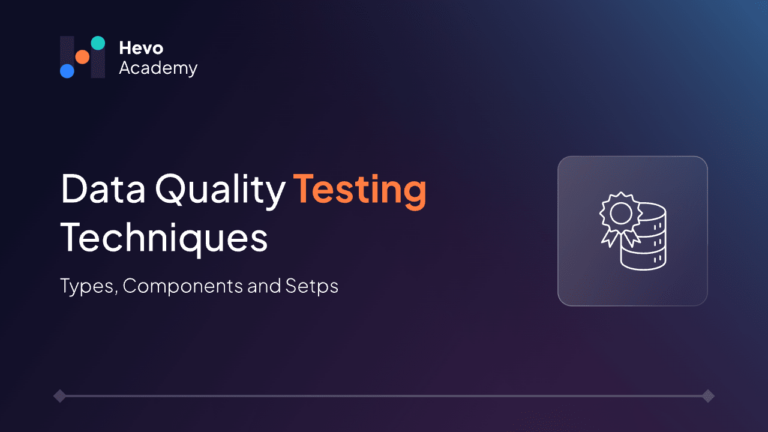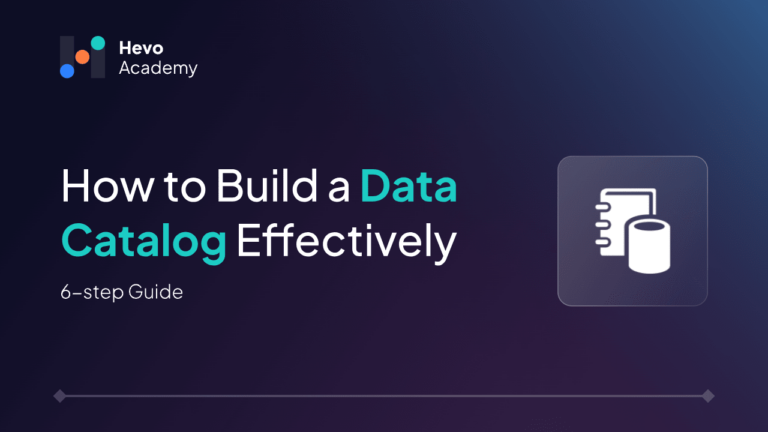How to Setup a Data Mesh? 10 actionable steps to build a data mesh include:
Table of Contents
- Understand and Align with Organizational Goals
- Educate and Foster a Data-Centric Culture
- Define Domain Boundaries and Ownership
- Establish Technological Foundations
- Implement Federated Data Governance
- Ensure Data Interoperability and Standardization
- Pilot and Iterate
- Monitor, Measure, and Optimize
- Encourage Cross-Domain Collaboration
- Scale and Evolve
Let’s delve into each of these data mesh implementation steps one by one to organize the data stack better. You can also look at various Data Mesh Tools.
What is Data Mesh?
Data Mesh is an architecture where the data ownership and management are distributed, in contrast to a single common data pool, as in the case of data lake or data warehouse frameworks.
Since data is considered a product and multiple teams own their data domains, it would be possible to make the data processes more flexible, scalable, and cost-effective for businesses. This means each domain (or team) is required to generate, manage, and disseminate high-quality data as a service, making it a more self-organizing and integrated data system.

Data Mesh is a new strategy of organizing data in and around an organization and utilizing it in different processes. Data Mesh does not follow the centralized, top-town structure as is seen in other approaches to handling big data. Hadoop treats data as a product, with each domain owning its data quality, availability, and governance.
Data Mesh is transforming data architecture by decentralizing data management and empowering teams to own their data domains. But implementing a Data Mesh can be complex. Here’s how Hevo makes it easier:
- Real-time Data Sync: Ensure that data is up-to-date across all domains with real-time data synchronization. Hevo’s powerful ETL processes keep your data fresh and reliable.
- Seamless Integration: Connect diverse data sources without writing code. Hevo’s no-code platform simplifies data ingestion from multiple sources, ensuring data consistency across domains.
- Scalable Pipelines: Build and manage scalable data pipelines effortlessly. Hevo’s intuitive interface allows you to create and maintain pipelines that grow with your data needs.
Get started with Hevo today and experience the simplicity of modern data integration.
Get Started with Hevo for FreeData Mesh Architecture
The Data Mesh Architecture is a new way to organize and use data in large organizations. It proposes a decentralized, domain-based approach to solving issues with traditional centralized data systems.
This architecture puts the responsibility of ownership of data in the hands of various individual business units and this data is viewed as a product which will be shared throughout the organization.
Here’s a breakdown of this approach:
- Domain-Oriented Data Products: In the architecture, there are domains involved including Domain A, B, C and each of them owns and controls their own data products. Having many centers with data fully controlled by teams leads to quicker and more efficient decision making by the teams.
- Data Discovery & Governance: One component is to ensure that any data product created is easy to discover, to understand, and to use while being compliant to data policies regardless of structural domains.
- Infrastructure as a Platform: Organizing at scale requires that a self-serve platform has the tools and technologies that domains need for managing and sharing data products.
Key Principles of Data Mesh Architecture
- Domain-Oriented Ownership: Every domain has its own data products, which guarantees the high quality of the data and their availability.
- Data as a Product: Data is used as if it is a regular business product, and it even has tagged documentation and stated quality assurances and interfaces.
- Self-Serve Data Infrastructure: Domains have the ability to use a self-service tool so they do not really have to rely on administrators and support from above.
- Federated Governance: Standardized governance policies make it easier to have interoperability and also compliance in all the domains which are involved.
- Check out this blog to learn more about Data Mesh Priciples.
Why should you Adapt to Data Mesh?
- Decentralised Data for Flexibility

Business can become more adaptable when the ownership of the data is decentralized. Finally, teams that understand their needs can sometimes make quick changes to how they collect and manage data without relying on a broader decision-making body.
- Data As A Product To Add Value
In other words when data is managed as a product then one gets some direction. Working collaboratively teams work to provide user-centric quality data experiences leading to enhanced value realization from data, throughout the organization.
- Self-Service Infrastructure for Scalability
Self-service data infrastructures allow the teams to manage the growth of their data operations effectively. There’s less congestion and the organization is able to expand without having to assign constant new additions to the core central data team.
What are the Core Components of a Data Mesh?
- Data as a Product
This way data becomes a product that guarantees that it is comprehensive, well documented and easy to use thus improving the utilization of data within the organization.
- Domain-Oriented Ownership
This means that each domain is self-responsible for its data; thus, everyone can work on, control, and optimize the data where they are for quicker decision making.
- Self-Serve Data Infrastructure
This enables teams to have easy access to data management tools and platforms that do not require full support from data teams hence making operations and scaling faster.
- Federated Computational Governance
governance helps to maintain data standard across domains while at the same time exercising self-governance, while keeping the data safe.
Step-by-Step Guide for Data Mesh Implementation

Step 1: Understand and Align with Organizational Goals
- Assess the Current Data Landscape: Begin by assessing the current state of data management –challenges, strategies, and technologies in use.
- Define Objectives: Make sure your Data Mesh project corresponds to the company’s vision and solves particular problems.
- Engage Stakeholders: Engage interested parties in various domains to determine their requirements and expectations.
Step 2: Educate and Foster a Data-Centric Culture
- Training and Awareness: Conduct awareness through training and workshops to make stakeholders understand Data Mesh and its implications.
- Promote Data-as-a-Product Mindset: Promote the idea of data as a product to teams and emphasize the importance of quality, care, and users.
Step 3: Define Domain Boundaries and Ownership
- Identify Domains: Subdivide the company by functional business processes or data categories.
- Assign Data Product Owners: Assign accountable owners for each data product, so that it sets fixed standard and standard practices.
Step 4: Establish Technological Foundations
- Select Technologies: Select tools that allow for distributing the data acquisition and processing tasks, including cloud services and orchestration tools.
- Build a Self-Serve Data Infrastructure: Provide means by which teams can work with the data and information individually, including retrieving, processing, and analyzing it.
Step 5: Implement Federated Data Governance
- Develop Governance Policies: Develop corporate security, quality assurance, and compliance standards that span the different domains.
- Federated Governance Model: It is still possible to achieve and sustain governance through the coordinated decentralization of control: top-level signals with domain-level freedom.
Step 6: Ensure Data Interoperability and Standardization
- Standardize Data Formats: Use unified data formats and protocols when transferring data between domains in order to avoid data exchange problems.
- Facilitate Data Discovery: Apply the fields that are easily searchable and usable by all the members of the organization.
Step 7: Pilot and Iterate
- Start with a Pilot: Implement the Data Mesh in a specific domain area as a pilot.
- Iterative Expansion: Roll out the application incrementally and modify based upon existing experience.
Step 8: Monitor, Measure, and Optimize
- Track Key Performance Indicators (KPIs): Establish goals and objectives to assess the success of Data Mesh and check the efficiency of its implementation.
- Continuous Improvement: Ensure that it is periodically revised in order to incorporate key performance indicators as well as changes in business environment.
Step 9: Encourage Cross-Domain Collaboration
- Facilitate Communication: Ensure that the various teams are able to share ideas across domains.
- Share Best Practices: Discuss implementation successes and challenges in the framework of the Data Mesh using the teamwork sections.
Step 10: Scale and Evolve
- Scale Gradually: To build the Data Mesh, take it to more domains and keep refining the processes all the time.
- Stay Agile and Adaptive: Be prepared to change technologies and business models which you adapt in the ever-evolving market.
By following the above steps, the organization can implement Data Mesh, improving the agility, scalability as well as utilization of data insights.
Conclusion
Data Mesh is a holistic way of managing data that embraces a decentralized ownership of data, and actually treats data as a product, with respect to scaling through the self-serving model. What’s more, organizational focus, data culture, and domain-oriented ownership improve the agility and decision-making in businesses. Data Mesh is delivered incrementally to guarantee data quality, governance, and operability across domains for innovation and collaboration. As the scale and progression approach these initial stages and the refinement continues, this structure helps organizations to utilize data properly, which makes it a strong approach to long-term success within the dynamic environment of the business world.
FAQs
1. What is the meaning of Data Mesh Implementation?
Data Mesh means moving to a new level sharing a data architecture, where, according to certain rules such as domain tenure as well as data as a product, teams are responsible for managing the data of the organization.
2. What are the 4 pillars of data mesh?
Domain-Oriented Decentralized Data Ownership: Every domain deals with its own data to make proper records of them.
Data as a Product: Data is considered as a product, with concepts of quality, usefulness, and user-centeredness.
Self-Serve Data Infrastructure: Teams can access tools to manage and utilize data independently, without central bottlenecks.
Federated Computational Governance: Maintains order and control of the data in different domains of an organization while giving freedom.
3. How to set up a data mesh?
Begin with the adoption of Data Mesh as the strategic business framework, reinforcing the data culture, and demarcation of domains. Then it is important to set up the prerequisite technology including self-serve infrastructure and the government policies governing them.
4. What companies implemented data mesh?
Netflix and Shopify are some of the large organizations that have adopted Data Mesh because of its flexibility in handling large volumes of information.





